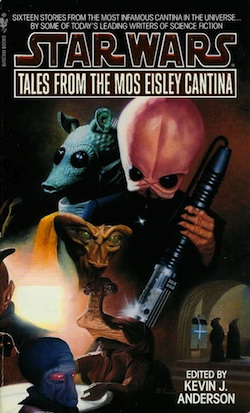I totally love the fact that the 1995 Star Wars short story anthology Tales from the Mos Eisley Cantina bothers to mention the fictional city in which the cantina is located. Like we would be confused if they didn’t say “Mos Eisley.” Oh, that cantina. Got it.
The existence of this book raises a weird question: why are we so obsessed with this low-budget parade of rubber masks and weirdo costumes glimpsed only for a second in the original movies? I think it’s because we might identify with these weirdos more than the “real” Star Wars characters.
Before I jump into the utterly unique and slightly bonkers anthology that is Tales from the Mos Eisley Cantina, can I just ask again why the hell did the word “jizz” keep popping up in the expanded Star Wars universe in the mid 90s? In Shadows of the Empire there is a gross space-gangster character named “Big Jizz/Gizz” who is also some kind of pig-man. In Tales from the Mos Eisley Cantina we learn that the type of music played by Figrin D’an and the Modal Nodes is a play on jazz called “jizz.” Which means that technically Obi-Wan cutting Ponda Baba’s arm off and Han and Luke’s first meeting are actually scenes filled with “jizz.” This had to be either a total accident or an in-joke being played on us by the Expanded Universe editors and writers, right?
The authors of the Cantina anthology are just as diverse as the wolfmen, aliens, hammerhead creatures, and guys with unreasonable sideburns whose backstories they are providing. From Timothy Zahn to A.C. Crispin to Judith and Garfield Reeves-Stevens to Barbara Hambly and beyond, the table of contents represents a sort of who’s who not only of Star Wars fiction, but tie-in media fiction in general. Personally, I remember being pumped that A.C. Crispin had a story in here as she wrote my favorite Star Trek novel Yesterday’s Son.
In another Star Trek connection, the Reeves-Stevens would go on to not only shepherd William Shatner’s audacious Star Trek novels, but also ended up being writers on the fourth and final season of Star Trek: Enterprise. Their Star Wars story here, “One Last Night in the Mos Eisley Cantina,” features the rare implication of time travel in the Star Wars universe. Focusing primarily on the “wolfman” Lak Sivrak and the creature known as the Lamproid, the events of this story cover the entire original trilogy. The Force is definitely seen in more of a science fiction phenomenon sort of way, which seems to continue a general trend of Star Wars novels leaning more toward science fiction tropes than fantasy in the ’90s.
Editor Kevin J. Anderson clearly had a lot of fun with this book, and the inclusion of his own story—“Swap Meet”—is one of the more satisfying pieces in the book. Here, we’re introduced to Het Nkik, a Jawa who doesn’t scurry away when faced with loud noises or people taller than him. Instead, he is on a mission of vengeance after a bunch of his buddies are killed in the infamous Sandcrawler massacre. A lot of the stories in this collection manage to weave in the events of A New Hope into the action at some point, allowing the reader to see the events through a different set of eyes. This might be part of the strange appeal of these various background characters; because they are so numerous and present, we can’t help but wonder what they get up to when the “heroes” aren’t around.
To put it another way, the background characters in all the Star Wars movies are both innocuous and startling. When Dr. Evazan tries to push Luke’s buttons by saying “I don’t like you either,” we get an instantly memorable character, who Kenneth C. Flint’s story “Doctor Death” then further renders as a terrifying mad scientist. Does this mean we look at the scene differently? Well, yes and no. It’s not like the various stories in Tales from the Cantina illuminate the kinds of things we’ve been craving. Instead, they demonstrate how much fun it is to imagine what some weirdo background character is up to.
My favorite of these has always been Jenny Oltion’s “At the Crossroad: A Spacer’s Tale,” which features the aforementioned sideburn-guy; BoShek. In the film, you literally see this guy for like two seconds as he’s talking to Obi-Wan at the bar before introducing him to Chewbacca. The story makes great pains to point out that BoShek was almost the guy who would have smuggled Obi-Wan and Luke to Alderaan, but due to some personal problems instead refers the boys to Han and Chewie. I continue to love this because it makes BoShek into a reverse Mary Sue. He’s a talented guy who is not a main character who could potentially take over the story, but doesn’t.
And there is what makes this little anthology so great, a Star Wars fan can see themselves in these more down-to-Tatooine characters, who maybe haven’t gotten as lucky as people named Skywalker. Because after the Millennium Falcon flies off to make history, people in the Star Wars universe still have to take care of their families, hold down jobs, and occasionally, when it’s been a rough day, hit up the cantina for a cold one.
Ryan Britt is a longtime contributor to Tor.com and prefers pap music over jizz.










